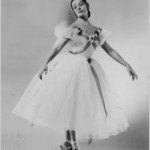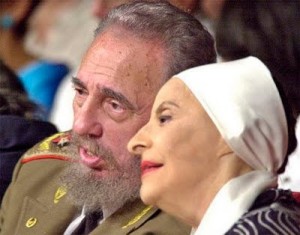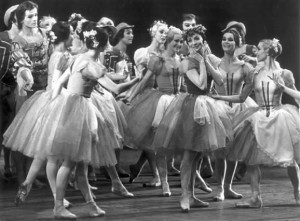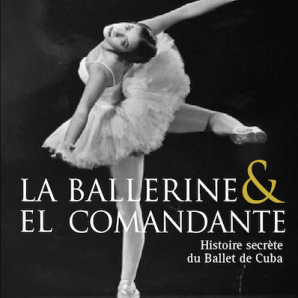Cuban dance critic Isis Wirth has presented “The dancer and the Commander”. The Secret History of the Ballet de Cuba (François Bourin Éditeur), a biography of Alicia Alonso, founder of the National Ballet of Cuba, highlighting its relationship with the regime of Fidel Castro.
“This book is the story of a diabolical pact between an artist and a dictator,” says the editorial in its online book presentation.
Alonso is one of the biggest stars of the twentieth century, “but this success is inseparable from the totalitarian regime installed by Fidel Castro,” it says.
.. A native of Havana, Cuba, Alonso, a dancer trained in the United States, became famous around the world before the Cuban Revolution exactly the November 2, 1943, when Alicia Markova couldn’t preformed her role of “Giselle” in the Metropolitan Opera House in New York City. It was then that the American journalist John Martin said ” she performed brilliantly, becoming one of the most outstanding performances of the season.”
While many Cuban artists, had fled to Latin America, Europe and the United States, Alonso, despite strong criticism from many, became an ally of the new Marxist dictatorship. With the exception of Alicia Alonso, Cuban artists all refused to support the new dictatorship.
Castro “in the ballet was a valuable propaganda tool, both nationally and internationally. Therefore offered to Alicia Alonso, who had very successfully begun his career in the United States, the means to pursue his dream. Return, the artist must support Policy Regime steadily, even in its most heinous “adds editorial presentation.
Before the Revolution, the island has produced some of the world’s finest artists and singers like Jose Domingo Claudio Brindis de Salas (known as the “Black Pagnini”), Damaso Perez Prado, Desi Arnaz, Cecilia Cruz, Lydia Cabrera, Guillermo Cabrera Infante, Nestor Almendros, Olga Guillot and Ernesto Lecuona. Thanks to Lecuona’s song “Malagueña”, Spain rose to fame in all corners of the world, including the People’s Republic of China. On the other hand, in the 40s, his single “Always in My Heart” (always in my heart) was nominated for Best Song Academy Award.
Alicia Alonso and Fidel Castro
As part of a strategy to gain fame and prestige in the world, which has condemned the brutal character of the dictatorial regime in 1959, the arts, especially dance, film and painting, were backed by the Cuban government, as in many oppressing nations during the Cold War, as the Soviet Union, East Germany and Bulgaria. Under this environment, Alicia Alonso realized his dream: officially founded the Ballet Nacional de Cuba (National Ballet of Cuba).
In order to improve the image of the island devastated by human rights abuses, mismanagement, dependence on the USSR and links with radical movements in the Third World, Fidel Castro supported the National Ballet of Cuba, providing financial aid to send to many young dancers, including Loipa Araújo, Mirta Pla, Jorge Esquivel, Aurora Bosch and Josefina Mendez meets worldwide, including the International Ballet Competition in Varna, and tours around the world.
In the 1960s, Alonso and the National Ballet visited Latin America, Europe, Vietnam, Mongolia and the People’s Republic of China. Meanwhile, Havana, capital city, was home to one of the biggest events in the developing world, where teams from Canada, Czechoslovakia, Spain, Guinea, Mexico, Nicaragua and the Soviet Union and other countries.
For his work on behalf of the Cuban dictatorship since 1960, Vilma Espin, sister-in-law of Fidel Castro, Alonso awarded the National Order “Ana Betancourt”, the highest honor of the Federation of Cuban Women.
Despite the human rights record of Cuba, ironically, Alicia Alonso is a popular figure in some regions. In fact, if Alonso had been a pro-Pinochet activist would not have a personality. She would not have been accepted by many governments and international organizations.
.. The dancer and the Commander, published in French, emphasizes that “tragic complicity,” says the editorial.
“United by the same passion for power, dancer and commander have written a story so pathetic ending in marasmus, gerontocracy and, for ballet dancers drain” believes.
 Isis Wirth-Armenteros, a graduate of Art History at the University of Havana, has worked for a decade in the National Ballet of Cuba. Her articles on dance, published in journals in Europe and Latin America, that were collected in the volume “After Giselle” (Aduana Vieja, Valencia, 2008).
Isis Wirth-Armenteros, a graduate of Art History at the University of Havana, has worked for a decade in the National Ballet of Cuba. Her articles on dance, published in journals in Europe and Latin America, that were collected in the volume “After Giselle” (Aduana Vieja, Valencia, 2008).
Sources: DDC/AlejandroGuevara/InternetPhotos/www.thecubanhistory.com
The Cuban History, Arnoldo Varona, Editor
Isis Wirth publishes ‘The dancer and the Commander’, a pact
Isis Wirth publica ‘La bailarina y el Comandante’, un pacto.
La crítica cubana de danza Isis Wirth ha presentado “La bailarina y el Comandante”. La historia secreta del ballet de Cuba (François Bourin Éditeur), una biografía de Alicia Alonso, fundadora del Ballet Nacional de Cuba, que destaca su relación con el régimen de Fidel Castro.
“Este libro es la historia de un pacto diabólico entre un artista y un dictador”, dice la editorial en su presentación de libro en internet.
Alonso es una de las más grandes estrellas del siglo XX, “pero este éxito es inseparable del régimen totalitario instalado por Fidel Castro”, señala.
.. Oriunda de La Habana, Cuba, Alonso, una bailarina entrenada en los Estados Unidos, saltó a la fama en todo el mundo antes de la Revolución Cubana exactamente el 2 de noviembre de 1943, al faltar Alicia Markova en el papel principal de “Giselle” en el Metropolitan Opera House de Nueva York City. Fue en ese entonces que el periodista estadounidense John Martin dijo de ella “se desembolvio con brillantez, convirtiendo en una de las actuaciones más destacadas de la temporada”.
Mientras que muchos artistas cubanos, habían huido a América Latina, Europa y los Estados Unidos, Alonso, a pesar de las fuertes críticas de muchos, se convirtió en uno de los aliados de la nueva dictadura marxista. Con la excepción de Alicia Alonso, todos los artistas cubanos se negaron a apoyar la nueva dictadura.
Castro “vio en el ballet un valioso Instrumento de propaganda, tanto Nacional como internacional. Por ello ofreció a Alicia Alonso, Que habia comenzado muy Exitosamente su carrera en los Estados unidos, los Medios para perseguir su sueño. A Cambio, la artista debio apoyar sostenidamente la política del Régimen, aún en sus momentos más abyectos “, áñade el editorial de presentación.
Antes de la Revolución cubana, la Isla ha producido algunos de los mejores artistas del mundo y cantantes como Claudio José Domingo Brindis de Salas (conocido como el “Pagnini Negro”), Dámaso Pérez Prado, Desi Arnaz, Cruz Cecilia, Lydia Cabrera, Guillermo Cabrera Infante, Néstor Almendros, Olga Guillot y Ernesto Lecuona. Gracias a la canción de Lecuona “Malagueña”, España saltó a la fama en todos los rincones del mundo, incluyendo la República Popular de China. Por otro lado, en los años 40, su sencillo “Siempre en mi corazón” (Siempre en mi Corazón) fue nominado a la Mejor Canción Premio de la Academia.
Alicia Alonso y Fidel Castro
Como parte de una estrategia para ganar fama y prestigio en el mundo, que ha condenado el carácter brutal del régimen dictatorial desde 1959, las artes, especialmente la danza, cinematografía y la pintura, fueron respaldados por el gobierno cubano, como en muchas naciones opresoras durante la Guerra Fría, como la Unión Soviética, Alemania Oriental y Bulgaria. Bajo este ambiente, Alicia Alonso se dio cuenta de su gran sueño: fundado oficialmente el Ballet Nacional de Cuba (el Ballet Nacional de Cuba).
Con el objetivo de mejorar la imagen de la isla, devastada por los abusos contra los derechos humanos, la mala gestión, la dependencia con la URSS y los vínculos con los movimientos radicales del Tercer Mundo, Fidel Castro apoyó el Ballet Nacional de Cuba, proporcionando ayuda financiera para enviar a muchos jóvenes bailarines, entre ellos Loipa Araújo, Mirta Plá, Jorge Esquivel, Aurora Bosch y Josefina Méndez, a nivel mundial se reúne, incluyendo el Concurso Internacional de Ballet de Varna, y los circuitos de todo el mundo.
En la década de 1960, Alonso y el Ballet Nacional visitó América Latina, Europa, Vietnam, Mongolia y la República Popular de China. Paralelamente, La Habana, ciudad capital del país, fue el hogar de uno de los eventos más grandes del mundo en desarrollo, donde participaron equipos de Canadá, Checoslovaquia, España, Guinea, México, Nicaragua y la Unión Soviética, entre otros países.
Por su trabajo en favor de la tiranía cubana desde 1960, Vilma Espín, hermana-en-ley de Fidel Castro, otorgado a Alonso la Orden Nacional “Ana Betancourt”, el más alto honor de la Federación de Mujeres Cubanas.
A pesar del historial de derechos humanos de Cuba, irónicamente, Alicia Alonso es una figura popular en algunas regiones del mundo. De hecho, si Alonso hubiera sido una activista pro-Pinochet no habría sido una personalidad. Ella no habría sido aceptada por muchos gobiernos y organizaciones internacionales.
.. La bailarina y el Comandante, editado en francés, destaca esa “complicidad trágica”, indica la editorial.
“Unidos por la misma pasión por el poder, bailarina y comandante han escrito una historia que termina de manera patética en marasmo, gerontocracia y, para el ballet, la fuga de los bailarines”, considera.
 Isis Wirth-Armenteros, graduada de Historia del Arte en la Universidad de La Habana, trabajó durante una década en el Ballet Nacional de Cuba. Sus artículos sobre danza, publicados en revistas especializadas de Europa y América Latina, fueron recogidos en el volumen Después de Giselle (Aduana Vieja, Valencia, 2008).
Isis Wirth-Armenteros, graduada de Historia del Arte en la Universidad de La Habana, trabajó durante una década en el Ballet Nacional de Cuba. Sus artículos sobre danza, publicados en revistas especializadas de Europa y América Latina, fueron recogidos en el volumen Después de Giselle (Aduana Vieja, Valencia, 2008).
Sources: DDC/AlejandroGuevara/InternetPhotos/www.thecubanhistory.com
The Cuban History, Arnoldo Varona, Editor
Isis Wirth publishes ‘The dancer and the Commander’, a pact







